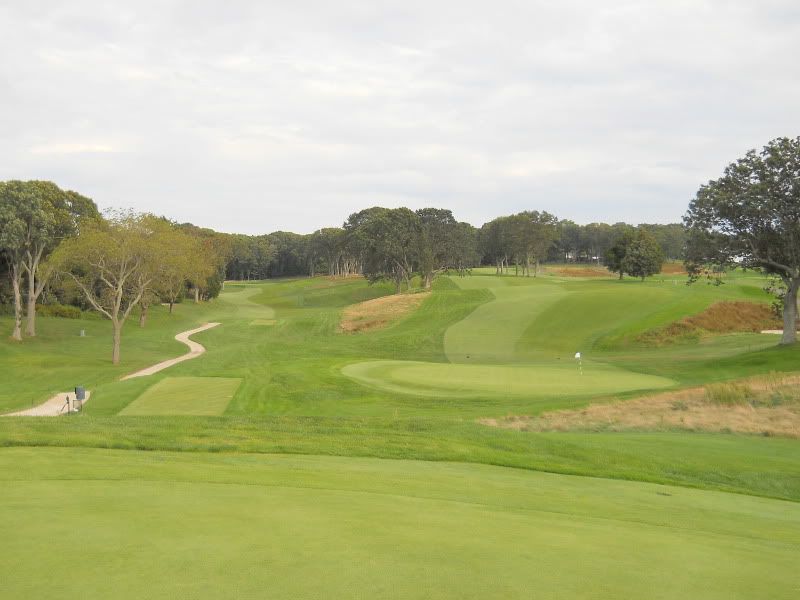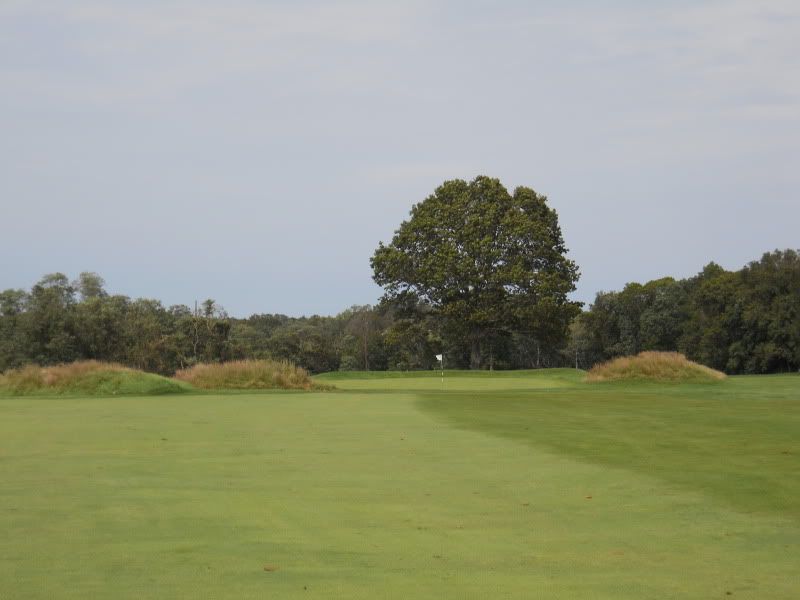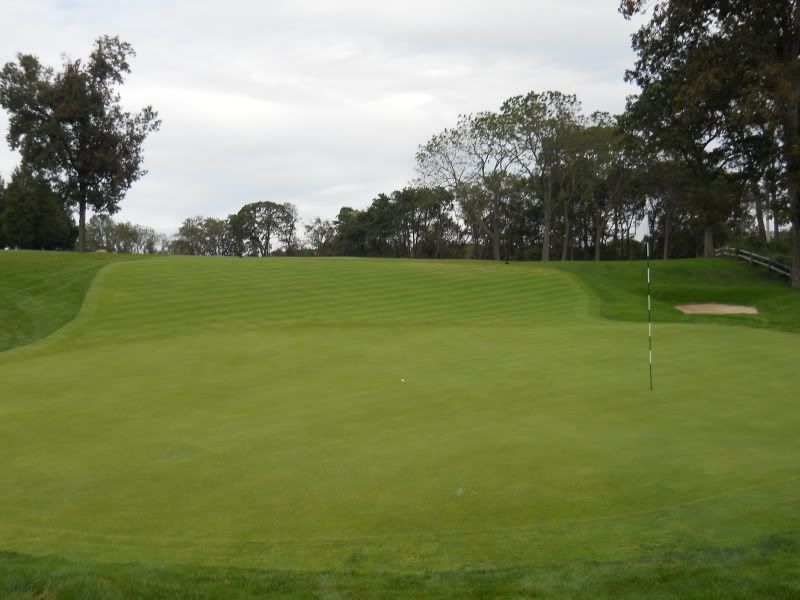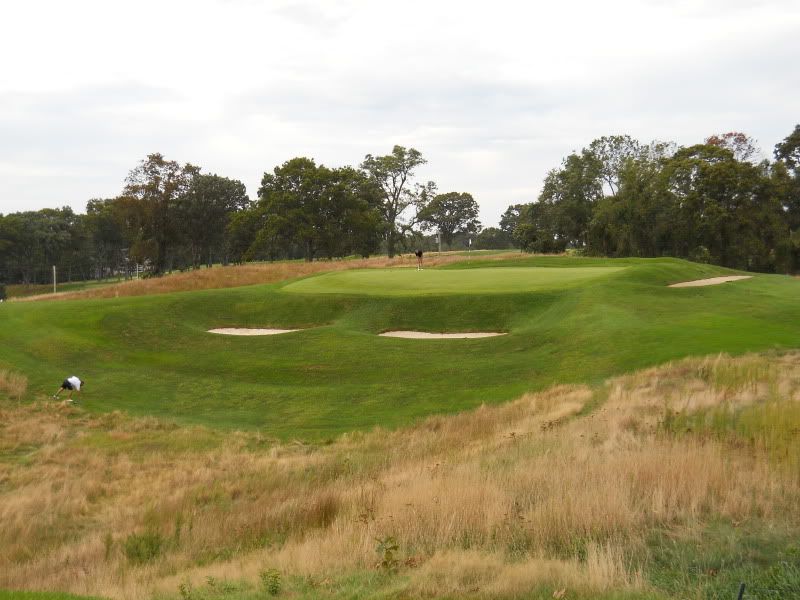
The Other St. George’s (Long Island)
…In the name of God, St. Michael, and St. George,
I give you the right to bear arms
and the power to dispense justice.
Rise, King Arthur…
—The words spoken by Sir Uriens of Gore as he used Excalibur to knight Arthur Pendragon and install him as King—
STONY BROOK, NY – Never have I been so grateful that a friend has no sense of direction, because his colossal blunder in geography led me to a course that immediately skyrocketed to the top of my short list of all-time favorites – St. George’s Golf and Country Club.
No, not that St. Georges, the other St. George’s, the one near Stony Brook, Long Island, not the British Open venue in southern England. But now that the confusion is cleared up – Take heart! – because this is our St. George’s and not only is it a proper rejoinder to its famous brother across the pond, it is unquestionably one of the greatest courses you’ve never heard of, but absolutely must see.
When Mike from Greenville – not only a lifelong player and gung-ho fan of excellent golf architecture, but a Good Friend of Golf – heard I was writing a series of articles on the private clubs in the Five Towns area of Long Island, near New York City, he had some advice. Mike is particularly well-travelled, and when he recommends a golf course, he’s usually spot on. So he decided to recommend a course to me…
But he’s new to New York City, a recent transplant from South Carolina. As a general rule, it takes about ten years of living here to begin to know your way around.
So far, he’s flunking geography. Here’s why:
“You need to see St. George’s, a 1917 Devereux Emmet design that Gil Hanse perfectly restored! It’d be a great course for you to write about!” he said excitedly.
“Well, that’s great, Mike. But I’m right in the middle of writing a series of pieces on the Five Towns clubs of Long Island,” I replied.
“It might be perfect for your series,” he countered. “It’s not far out on Long Island.”
“Is it near the Five Towns?”
“It’s near the Five Towns,” he answered in a voice that gave the impression that he wanted to end the sentence with “I think…”
That should have given me enough warning to…you know…look at a map before booking my round there. But I was busy – complex entertainment and intellectual law practice to manage, family to care for, stack of golf articles that won’t write themselves, high maintenance girl to wine-and-dine, chumps-lunkheads-and-dingbats to keep at bay – you know how life in NYC is. But hey, I had my clubs, I had my Long Island Railroad ticket, and I had my friend’s rough guess that the course was near the Five Towns. What else did I really need?
It’s only when it was five minutes to boarding time when I noticed that St. George’s is near the Five Towns like New York is near Philly. Two-and-a-half hours and three train changes later I arrived in Stony Brook, almost as far out on the North Fork as you can get.
My friend got confused; it’s actually somewhat near the Three Villages area of Long Island instead, but all mis-directions should turn out this well, because St. George’s isn’t just a hidden gem. It’s a Silmaril, a jewel that burns with the light of stars, a beacon of light shining brightly to illuminate the absolute best principles of golf design. And as expected, the way forward into the 21st century and beyond should be to look back to great strategic principles and shaping/construction of the Golden Age.
ON THE COURSE

From the beginning you can tell St. George’s old school design concepts make it vastly superior and far more fun than modern penal architecture layouts by name-brand designers.
“It’s just a gorgeous piece of property with a terrific layout,” said architect Gil Hanse, who performed the restoration work at the club. “I had never heard of it before they contacted me, but my first thoughts upon seeing it were that the landscape was wonderful and the topography was perfect for a golf course. It has a combination of long flowing slopes with some more abrupt contours, so its variety of landforms made for really interesting golf holes.”
Indeed, Emmet found the best natural features on the land and designed the holes to play right into their teeth, making for thrilling golf. Some shots play softly uphill, some cascade thrillingly downhill, sometimes fairways seamlessly flow right into the green, but at all times, the golfer is captivated and entranced.
Like the U.K. links whose style it emulates, it’s an asymmetric out-and-back routing. The tired, hackneyed “doctrine of symmetry” (where you MUST have two par-3s and two par-5s on each loop of nine) was not forced upon the golf course. The 6,230 yards course plays about 350 yards longer because it’s a par-70, not 72, but never feels overly long. There are no brutish par-4s that devolve into boring driver-3-wood-wedge affairs. Instead, the golf must carefully think his way around the course to avoid cunning cross-hazards, fearsome false fronts at many greens, and deep bunkers everywhere. The greens are tiny, but fiendishly contoured and canted. There are few trees, so the wind whips viciously across the plain, making a mockery of the yardages on the card.
As a result, much like Royal Melbourne, the course defends par admirably without ridiculous length or ubiquitous water hazards. As such, St. George’s says more in 6,230 yards then Atlanta Athletic Club, Congressional, and Medinah say in 23,000+ yards combined.
Additionally, the par sequence is refreshingly unique. There is no rhyme, reason, or rhythm to the routing other than Devereux Emmet’s accurate reflection – not interpretation, but reflection – of what the land gave him. There are no par-3s in the first six holes (4-5-4-4-4-5) then four in the next nine holes (3-4-3-4-3-4-4-4-3) before the magnificent 4-3-5 finish.
The course can be divided into four distinct parts. The first three holes take you from the clubhouse to Sheep Pasture Road, which bisects the golf course with holes 1-3 and 11-18 on one side of it. A second street, Bennetts Road, intersects Sheep Pasture near the 11th hole, but then curves so that it forms a wishbone shape with Sheep Pasture, and holes 4-10 are inside the wishbone.
The wishbone-side holes can be divided into two parts – holes 4-6 on one half of this parcel, and holes 7-10 on the other. Finally, the player re-crosses Sheep Pasture Road for the remainder of the round.
The first six holes are utterly sublime, each better than the last. Two through five play with the prevailing wind, then six and seven turn back into the teeth of the gale, making them play much longer. The gentle bending dog-leg left first hole features a green guarded by a massive false front that ruthlessly sheds balls back down the fairway. Aim for the hospital and play a draw, but watch out for the reverse camber of the fairway – the hole sets up right-to-left, but the fairway slopes severely to the right. It’s a defense that Olympic Club – next year’s U.S. Open venue uses to great effect.
The fairway of the par-5 second is peppered with deep fairway bunkers: some of which are tiny pits, others are long scars, but they all form a great cross hazard to be traversed strategically. Interestingly, the hole shares a gargantuan fairway with the 18th hole.
The drive at the third is blind to a fairway viciously canted from right to left, but a well-placed shot that starts far enough right will run like a scalded cat down the slope to a good angle and more even lie than the severe slope of the right side. The downhill approach can be aerial or a bump and run shot that follows the fairway contours, which melt smoothly and seamlessly into the green, (another common theme and great benefit of the design).
Another blind drive greets the player at the fourth, but it’s the approach that is even more fascinating.
“It’s one of my favorite holes on the course,” explains club president John Ammerman. “The square-shaped green is framed by big shaggy mounds and completely surrounded by sand on all sides, including two deep bunkers in front.”
“It’s one of my favorites too. No matter how long you hit your drive on that holes, you’ve got a tough shot to hit that green,” added club champion Mike Schwenk, who’s name appears on the list of champions with Devereux Emmet himself. Schwenk also once caddied at Friars Head for no less a personage than Roger Waters of Pink Floyd.
“You can tell that Emmet had some kind of relationship with C.B. Macdonald and Seth Raynor,” he adds, “because the fourth green resembles those square/geometric shaped greens that they used to build at the courses they designed.”
Indeed, the approach to that green is thrilling: the type of shot golfers would have seen 100 years ago. For the few blessed hours that you are on the course, St. George’s turns the clock back to an older, more civilized and genteel time, where you can see what golfers have seen for centuries.
In that regard, the course is a restorative, an elixir. You get that incomparable, that electrifying feeling of being both alone and one with the golf course, where everything else – job, cares, life – have vanished and it’s just you and the course and the touch of the Golf Gods. I call that feeling “The Vortex,” and I’ve experienced it at only a precious few times and places in my life: the tidal holes at Bulls Bay in South Carolina, the middle holes at National Golf Links of America, the cliffside holes the Shore Course at Monterey Peninsula Country Club, Ballyneal and Sand Hills, and only a few other courses around the country. It’s at those moments when you experience the true beauty of golf.
“By the time you’ve reached the fourth hole, you’re hooked,” added golf architecture expert Pat Mucci. “If by the fourth hole you don’t realize you’re on a truly great golf course, you just don’t know anything about golf architecture,” he finishes, nodding with conviction.

Happily, St. George’s continues to take your breath away time and again, with such epic peaks in excitement throughout the round. The par-5 6th is another sublime hole. The tee box turns you back into the prevailing wind, so the mere 487 yards play considerably longer, and the two cross bunkers that bi-sect the fairway and then cut in front of the green make it longer still. The approach plunges down twenty feet to a green well below the fairway level. It’s the type of hole that just isn’t built any more.
“There are a lot of downhill approaches at St. George’s and I really like that. I don’t know why we don’t see more of that now,” Hanse noted. When asked if perhaps Emmet was simply designing into the teeth of the most dramatic features of the property to create the most dramatic golf holes, he agreed.
“That’s exactly what the best architects do to build the best courses,” he stated. “You have to make the best use of the landscape, and at St. George’s there are quite a number of excellent downhill approaches. It’s that variety that is one of the reasons why St. George’s is such a unique and excellent club.”
The par-4 10th features another of those thrilling downhill approaches. After a long drive, the fairway cascades down sharply to a green hard by Sheep Pasture Road which slopes away from the player.
“You have so many options on that hole,” observed Bruce Moulton, an excellent golfer in his own right and another well-respected expert on Golden Age architecture. “You can try to fly it to the green, but you better be able to pull it back! Or you can run it up. You can even putt it from well back in the fairway. That’s definitely one of the coolest holes I’ve ever seen, let alone one of the coolest holes on the golf course.”
12-13 are the backbone of the homeward nine, two long, stout par-4s demanding both length and accuracy to get home. Set in a wide corridor of trees, the 12th is a saddle fairway, roller-coasting up and down heaving terrain, finally ending at a curvaceous green with pronounced contours. The player then turns back in the opposite direction, playing a long drive to a plateau before hitting an approach that plunges sharply downhill and over a swale to an inverted bowl of a green.
“13 is the first hole that comes to my mind when I think of St. George’s,” says Hanse. “That’s got the best downhill approach of all. You have to carry the second shot over that valley and then the ground tumbles down and then back up to a green is perched on that rise. It’s just yet another example of Emmet pushing the envelope in designing a golf hole, but doing it in a good way, where it infuses both strategy and options into the design, not just dictating that one shot can be played or making it hard for hard’s sake. That’s the key to designing a truly great golf hole, and that pushing the envelope and getting a truly unique and memorable hole is one of the hallmarks of Emmet’s architecture.”
If there is one flaw at the course, it appears at 14. A pond sits in front of the 16th tee to catch cold-tops, but St. George’s is designed over a small plot of land, so the same pond can be reached if one hits a flat-out goofy slice off the 14th tee. The problem is that the pond is blind from the 14th tee, so a short push-fade could end up wet.
Still, what my girlfriend Britt once said about people holds true about golf courses as well.
“No one is perfect, and if they are perfect, then that’s their flaw,” she explained sagely.
Then she turned and stared at me with an innocent look that didn’t fool me for one second.
“What’s my flaw, Jay?” she asked.
I didn’t even need a millisecond to get the right answer. I’ve studied for that test.
“You’re perfect,” I said with a demure smile. I was wearing her a second later. She tastes like strawberries.
Anyway, the course has a mighty finishing stretch. The Redan-ish par-3 15th is a favorite of many players with its false right side and deep Emmet-shaped bunkering ringing the green.
“But it’s the view from that tee box encapsulates our whole course,” explains Ammerman. “You can see wide vistas across a number of different holes.”
It’s a great view, but don’t let that lull you too sleep. Like the other par-3s, it’s much tougher than it looks. In fact, while none of the five par-3s exceeds 185 yards, each of them is dangerous. Slick, sharply canted and fiendishly contoured greens are almost completely surrounded by below-fairway grade bunkers. None of them are “breather” holes or a pushover, and if you short-side yourself, it’s likely a dropped shot.
In fact, Emmet (and Hanse for that matter) could give several modern architects lessons about how to defend a golf course without length, because Emmet’s short holes are just as dangerous as the long ones. Take the 322-yard par-4 16th hole. The direct line to the hole is fraught with peril, a wonderful “Line of Charm” as Max Behr would say. To try to drive the green – lunacy to be honest – one hits a majestic, towering shot over a huge elm tree, which then must avoid the deep, narrow trench bunker along the right side and scoot through a valley that fronts the green and ascend the second-steepest false front on the golf course. More bunkers guard the left side. Sane individuals aim the knee of the dogleg and hope to carve a gentle fade to a plateau for a pitch every bit as delicate as that faced at the fourth hole.
“Oh yeah, that’s a shot that has some real pucker factor,” agreed Hanse. “But that’s one of the things about Emmet. He added a lot of sex appeal to his short par-4s. They are really interesting.”

The most severe (and difficult) false front is at the par-3 17th, 122 yards of sheer terror, almost as visually arresting (and nerve-wracking) as the 17th at Sawgrass. It definitely brings to mind its brother hole, the eerily similar par-3 16th at Royal St. Georges in Sandwich, England. (That’s the hole where Thomas Bjorn left the Claret Jug in the greenside bunker short of the toughest false front on the golf course.)
Like its brother across the pond, the front third of the 17th green at St. George’s is completely false and will ruthlessly roll balls back off the green, down the embankment and into a bunker 10 feet below fairway grade. Then you face the same false front while playing out of the deepest bunker on the course. Good luck with that: let me know how it turns out…
Oh, and guess what! There are also bunkers left and shaggy mounds behind the green. Once again, Emmet proves you don’t need length to build a great golf hole. This hole says more in 122 yards than the 15th hole at Atlanta Athletic Club said in 262 yards, more than twice its length.
The 18th is a glorious summation of all that came before. Emmet give us another show-stopper of a par-5, this time a sweeping dog-leg left with the knee guarded by long rough, deep pot and trench bunkers, and broken ground, but the closer you play to the trouble, the shorter the approach to a green severely canted right to left. There is plenty of room out to the right, but they way home is much longer.
As an aside, should we not include Emmet in the short list of architects who design the best par-5s? Right up there with Alister Mackenzie, perhaps? Garden City Golf Club, Leatherstocking, St. George’s, Seawane: at par-5s, Emmet always has something both bold and interesting to show us, whether it’s a great cross bunker, (like seven at GCGC, six at St. George’s, or nine at Seawane), a wonderfully canted fairway, (like four at GCGC, 15 at Seawane, or four and 11 at Leatherstocking), or a terrific short but dangerous match play hole, (like 17 at GCGC).
We also should include St. George’s near the top of the list of Devereux Emmet’s indisputable masterpieces, right behind Garden City Golf Club. Between the strategic options offered by the center-line hazards and the changing winds, the course makes you think about every shot.
“It’s interesting every time you play it, and because of the wind, it’s completely different not just from day to day but from round to round,” Hanse surmises. “It’s a truly great member’s course with something different at every turn. So many different things can happen to you on that golf course, both bad and good! On any given day, you’ll experience a lot of highs and lows and they won’t always be in the same place. You could play St. George’s your whole life and still find something new every time.”
Devereux Emmet Society founder and president Mark Chalfant agreed. When asked if he thought St. George’s was Emmet’s best course except for fabled Garden City Golf Club he replied, “It may very well be. Then again, St. George’s was Emmet’s home course. You’d expect him to go the extra mile there.”
Much of the credit for St. George’s remarkable resurgence can also go to the sterling restoration work done by Hanse, whose talent at restorations work wins him as much well-deserved acclaim as his original designs. Fully understanding the importance of their precious architectural heritage within the golf design world, the club was wise enough to accentuate that lineage and legacy by returning the course to the 1917 design.
“Hanse was like an archaeologist peeling back layers of earth and finding something interesting at every turn,” stated Ammerman. “The goal was to do exactly that – restore. For 50 years, nothing substantive was done to design of the course, which wsas a good thing. Gil just helped us turn back the clock to reveal what was long dormant.”
Some bunkers had grown over and had to be recreated, a few trees had encroached fairways and needed to be cut or pruned, and some grassing lines had moved and had to be remowed…and that’s pretty much it.
“They really didn’t have to do anything major, just showcase what Emmet designed in the first place,” said Hanse. And with that, Team Hanse and course super Adam Jessie were off like a hound on the trail of a fox. The result was one of the best restorations accomplished since Bethpage Black and the return of a shining jewel to the American golf diadem.

From the opening tee shot in the shadow of the gorgeous windblown birch, the endearing and iconic sentinel of the course that resembles the White Tree of Gondor of Lord of the Rings fame to the final putt at the 18th green overlooking the vast expanse of the great windswept plain, St. George’s is the quintessential example of an ancient golf splendor, recalli9ng the glory for the Golden Age and inspiring the architecture of this Second Golden Age we are privileged to enjoy now.
St. George’s is the kind of golf course that makes you wish that the rest of the World would melt away leaving just you and the course, and all you need in life is your clubs and golf balls. If I had a futon, my iPod, and unlimited sushi and juice, I could live on the third through sixth holes for the rest of my life, with an occasional sojourn across the road to play the other holes. The heck with “OCCUPY WALL STREET,” I’m all for “OCCUPY SHEEP PASTURE ROAD.” Set up my tent and my generator and have my mail delivered there. Frequently, my girl could come to visit. It’s that good – like “the best of Dire Straits and Paul McCartney combined” good. And you know there are courses that good. That’s why you play golf in the first place.
“People always ask where we’ve been all their lives and we just say ‘right here.'” said Ammerman.
That’s terrific. Just don’t ask if “right here” is near the Five Towns.
DON’T CALL IT “QUIRKY”
The first word that frequently comes to mind when players initially see St. George’s is “quirky,” but a particularly learned discussion has been started between some of the expert analysts from Golf Club Atlas, a few architects, and others in the golf design industry regarding not only whether that word carries an undeserved negative connotation, but also what the word “quirky” means in the first place.
Defining the word wasn’t as difficult as some thought. Well respected expert Patrick Mucci endeavored to draw similarities to the famous American legal decisions on the topic of pornography.
“You know it when you see it,” Mucci wrote, but I wasn’t so sure and countered, triggering this exchange:
“Pat, I definitely do not think we know it when we see it. I think people have different definitions. You know when you see a picture of a woman’s exposed and opened v—- and it’s not a medical picture and she’s smiling lasciviously – that’s pornography…but why is a severe false front quirky? Why are severely canted fairways quirky? Should they be? I don’t think they should be. When does something go from “really creative” or “classic golden age architecture” to “quirky?”
Always quick with a quip, Mucci replied with his usual color and pluck.
“Smiling lasciviously and pulling the v—- apart? Who says that’s pornography? That’s one of my favorite positions!”
“Now, Pat!” I admonished, “the sight of you smiling lasciviously and pulling apart your v—- is enough to send everyone running out of the building screaming like a scene from The Towering Inferno…”
“Be that as it may,” the good-natured Mucci responded, ‘quirky’ or no, St. George’s is a lot of fun to play, is a creative design, is unique, and should be studied by anybody who wants to learn about golf architecture. ‘Quirky’ shouldn’t be a negative. It just means that you frequently see creative elements from Golden Age architecture, frequency being the key. That and the fact that they tenbd to be pronoun ced, not subtle. So ‘quirky’ shouldn’t be an insult. ‘Goofy’ is an insult, not ‘quirky.'”
Mucci’s vulva aside, most people agree with him that quirk should not be a negative, though the word does paint a somewhat diminished picture to the general golfing public. I wondered if labeling St. George’s as “quirky” does it a disservice, and most people agreed with my expounded positions – the word carries a bit of baggage with it, and St. George’s “quirk” is really excellent architectural design from the Golden Age and using the most prominent and pronounced features as part of the design, which gives the course so much of its integrity and character.
“Amongst the general golfing public yes, it’s seen as a negative, but it shouldn’t be. In people’s minds they think it’s gimmicky and ask ‘Where’s the windmill?” began Hanse. “But among people who take the time to appreciate and educate themselves about golf course architecture, ‘quirk’ has a more sophisticated meaning, and takes the craft to a higher level of creativity.”
In other words, it’s really a compliment.
Architecture experts Keith O’Halloran and David Harshbarger agreed, noting that blind shots, severely uphill or downhill approaches, and false fronts are among the unusual things you see at Golden Age courses that sometimes unfairly get pigeon-holed as merely “quirky.”
“I do think that in many circles, using the word quirk is not a glowing endorsement,” began O’Halloran, “but in some other circles it’s not a terrible thing. Sometimes people just get taken aback by something they weren’t expecting,” he noted wisely. “Others, not willing to blame themselves for not understanding the architecture or not willing to blame their high score on their poor play, take it out on the hole, labeling it as ‘gimmickie’ or ‘Quirky,’ he concluded.
Harshbarger agreed, and further expounded:
“The other thing you see at St George’s is the amplitude of the features, or their maybe the bold self-assuredness they exude. The big mounds in the green at 8 are unapologetic. The bunkering at 4 is unabashedly geometric, including the tail back right. The string of bunkers and mounds between 16 and 18 are clearly unnatural, but just as clearly demand your attention in defining the course. Even less bold courses can be filled with quirk when they have false greens, visual deceptions, non back-[to]-front greens, etc…”
Harshbarger then called the features “beguiling,” and he’s right. They are the charm and character of the course, the ineffable lifeblood of St. George’s that makes it both rare and wonderful.
But the discussion needs to continue, through the continued championing of Golden Age architecture, the promotion of the resurgence of this Second Golden Age, and the continued edification of the casual golf fan. Don’t just write something off because it’s quirky. Too often we dismiss something as unworthy of our time or consideration simply because we are preconditioned and afraid of change. But in the highest circles of golf course architecture, quirk is the4 new cool, so get out of the way if you can’t lend a hand for the times they are a changin’.




